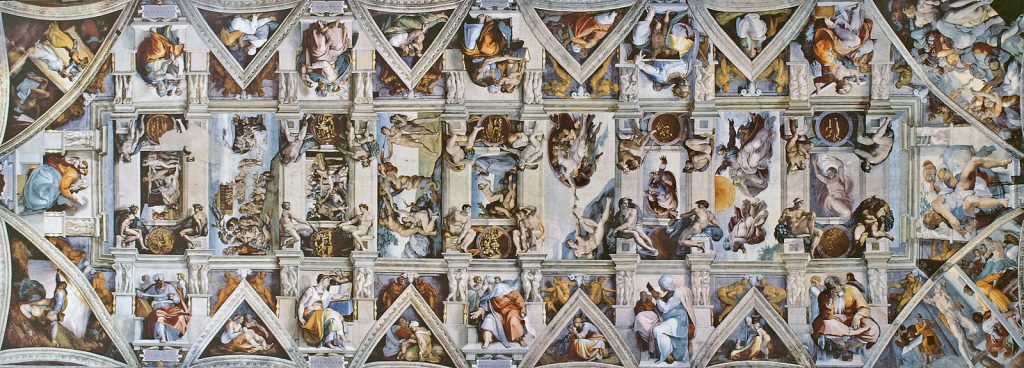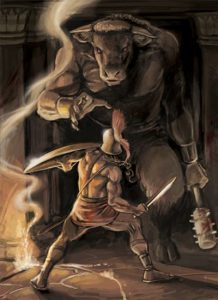From 1508 to 1512, it took Michelangelo five long, torturous years to complete the rigorous task of painting the ceiling of the Sistine Chapel. Spanning more than 10,000 square feet, the iconic piece of high Renaissance art is familiar to many people. Nevertheless, despite Michelangelo’s distinct ability to imply powerful expression and emotion into his art, most people fail to interpret the full story behind the talented artist’s five-year journey. Many may not realize that the beautiful, intricate depictions attributed to Michelangelo were actually painted by an unskilled artist. Likewise, one would not even dare think that the hand behind the brush had minimal interest in painting such marvelous masterpieces.
Michelangelo was by no means recognized as a skilled painter in his time. His fame, rather, came from the sculptures he chiseled in Rome and in Florence in his earlier years. His first sculpture in Rome was Bacchus (1496-1497), which he sculpted for a French ambassador’s barber. The French ambassador then commissioned Angelo to sculpt the Pietà (1498-1499). It was to be Michelangelo’s first contribution to the Catholic Church. The sculpture depicted the Virgin Mary holding the dead body of Jesus Christ. It was widely admired for the pure and simple expression of Mary and the holy serenity of Jesus even in the stillness of death. A few projects later, Angelo worked in Florence, sculpting the massive statue of the biblical hero David. The sculpture David (1501-1504) left Florentine citizens and artists, such as Leonardo Da Vinci, in awe. Eventually, he was assigned to work with Da Vinci painting war cartoons on the walls of the great municipal hall of Florence, known as the Palazzo Vecchio. After treating Da Vinci with severe discourtesy, he was summoned to Rome, by Pope Julius II for a new commission in 1505.1

Upon arriving in Rome, Michelangelo was employed to work on a mausoleum, or sepulcher, for the pope. Julius desired a tomb spanning eight hundred square feet, three stories high, and adorned with twenty six statues. He was willing to pay Michelangelo more than two hundred thousand crowns to complete the grand project. However, the pope’s desires were too extravagant and the expense was absurdly high, so the St. Peter’s basilica, where he desired his tomb to lay, would not allow it. Julius II and Angelo had developed an intimate friendship at this point, as they shared a proud, willful, and honest character. It was tough love between them; they always found a way to reconcile after constant quarreling and the loss of each others’ trust. Suddenly, however, after being denied his mausoleum, the pope’s demeanor changed and he excluded Angelo from the Vatican.2 Donato Bramante, a papal Italian architect, instigated this trouble by warning the pope of the evil omen he invited by constructing his death monument during his lifetime. Jealous of Angelo’s illustrious talent, Bramante encouraged Julius to hire Michelangelo to paint the ceiling of the Sistine Chapel instead, hoping that he would fail miserably. Meanwhile, triggered by his banishment, Michelangelo decided to abandon the pope and return to Florence.3
Three years later, in 1508, after multiple attempts by the pope to forcibly return the skilled artists to Rome, Michelangelo finally met with him. The pope hired him to paint frescoes of the twelve Apostles on the Sistine Chapel ceiling, but Angelo hesitated, knowing that he had inadequate practice with fresco-painting. Nonetheless, Julius repeatedly urged Angelo to accept the job, until finally, Angelo reluctantly gave consent under one condition.4 Michelangelo asked that something more tasteful be painted on the ceiling; he wanted to be allowed to “do as he pleases.” He suggested nine scenes from the book of Genesis, beginning with the creation of the world and ending with Noah and the flood.5

The pope granted his request, and Michelangelo started right away. Bramante was given the task of constructing the scaffolding, but his approach was inefficient and it made holes in the ceiling. This angered Angelo so much that he got the pope’s permission to banish Bramante, and he make the scaffold himself. After making a better scaffold structure, Michelangelo still doubted his abilities for the task, so he summoned his childhood friend, Francesco Granacci, to aid him in preparing designs for the frescoes. Angelo got the hang of it quickly, and soon enough, Granacci and two other assistants were painting over the master’s chalk outlines. Michelangelo’s arrogance engulfed him though, and he regretted inviting his three assistants, who could not express the art in harmony with his detailed ideas. He sent his friends back to Florence and set forth on the project alone, where he spent most of his days alone in the sombre space between the platform and the ceiling. Michelangelo became frustrated; he ached daily from having his head thrown back, spine arched downward, and face covered in paint. Matters only got worse as the winter neared.6
From May until the first winter, nearly one third of the ceiling was complete, but it was all ruined by mold that developed under the perfect conditions of the cold weather and moisture in the Roman lime Michelangelo used to make the plaster. Devastated, Angelo gave up, and shouted to the pope, “I told you I was no fresco-painter; what I have done is ruined.” He took a break from the project for nearly a year, as he waited for favorable weather and for the mold to disappear. It was after this break that Michelangelo’s frescoes underwent an evident change. The paintings became larger and more expressive and emotional. He continued the back-breaking work until it was finally completed in 1512.7
Notably, one well-known fresco that depicts The Creating of Adam, clearly demonstrates Michelangelo’s shift in form and style. The large twisted bodies are very expressive, and the movements portray a strong emotion that can be easily perceived, even from the chapel ground! This style completely contrasts Angelo’s first few frescoes, which were small and complicated. In particular, the scene of The Great Flood is full of action when viewed up close. The fresco contains four stories alone, but they cannot be seen well from the ground. Michelangelo was aware of this issue, but he decided not to feed his frustration and continued painting the ceiling, with the new approach.

Completing the job was not easy for Michelangelo, he had to fight through the strong hatred he developed while painfully painting the frescoes. Some scholars believe that Michelangelo suffered from deconditioning syndrome, which is a state of physical and emotional lethargy as a result of a lack of exercise or movement for long periods of time.8 However, this is due to a common misconception that he worked laying down on the scaffolds, close to the ceiling. In fact, Michelangelo spent hours upon hours with his head bent back, his spine curling in on itself, and his feet aching because he painted standing upright on his designed scaffold. He regretted ever accepting the task; he even wrote a poem in 1509 describing how much he loathed the whole situation:
From the year 1513, when the chapel finally reopened to the public, until the present day, Michelangelo’s arduous accomplishment lives on as a renowned piece of art. The paintings have acquired a low tone due to withering and reckless care, but they still stand to show that he conquered the task and surpassed those who doubted him. Although it may have costed him physical and mental health, his dedication and skill continue to inspire artists and historians, and astonish all those who view his works.10

- Moses Sweetser, Michael Angelo (Michigan: Houghton, Osgood and company, 1878), 23-35. ↵
- Moses Sweetser, Michael Angelo (Michigan: Houghton, Osgood and company, 1878), 34. ↵
- “Michelangelo’s Painting of the Sistine Chapel Ceiling,” ItalianRenaissance.org, May 9, 2013, http://www.italianrenaisance.org. ↵
- Moses Sweetser, Michael Angelo (Michigan: Houghton, Osgood and company, 1878), 48-49. ↵
- “Michelangelo’s Painting of the Sistine Chapel Ceiling,” ItalianRenaissance.org, May 9, 2013, http://www.italianrenaissance.org ↵
- Moses Sweetser, Michael Angelo (Michigan: Houghton, Osgood and company, 1878), 50. ↵
- Andrew Graham-Dixon, Michelangelo and the Sistine Chapel (New York: Skyhouse Pub, 2009), 1-35. ↵
- Raffaella Bianucci et al., “Michelangelo Buonarroti (1475-1564) had the Deconditioning Syndrome While painting the Sistine Chapel Ceiling,” Medical Hypotheses 113, (April 2018): 13-14. ↵
- Gail Mazur, “Michelangelo: To Giovanni Da Pistoia When the Author Was Painting the Vault of the Sistine Chapel,” Poetry 1, no. 1 (2005): https://www.poetryfoundation.org/poems/57328. ↵
- Moses Sweetser, Michael Angelo (Michigan: Houghton, Osgood and company, 1878), 57-58. ↵



120 comments
Margaret Maguire
The Sistine Chapel is a really neat place, the entire room is brightly painted with all of the paintings Michelangelo painted. I didn’t know that the style the Sistine Chapel was painted in a style that Michelangelo really disliked. I though it was interesting to find out that while he was painting the ceiling the mold attacked his work and he blamed it on the Pope and stop his work for a year. He did a really nice job for someone how was forced into working on such a big project.
Kimberly Parker
The Sistine Chapel is such a remarkable piece of art, with all of its intricate details. Michelangelo took on a huge challenge in making this masterpiece, especially since he wasn’t really knowledgeable in the fresco-painting field. But he accepted the challenge and put in a lot of effort. And eventually, once he finished, all of his efforts paid off. He was so committed to completing the painting, that it took him 5 years to finally complete it, and the conditions that he had placed his body in order to paint it were excruciating but he accepted them in order to finish.
Amelia Hew
Michelangelo’s art, the Sistine Chapel was a remarkable piece of art. He was brave enough to accept the challenge of fresco-painting despite being not too knowledgeable in this particular field. However, this art project costed him his health due to him constantly looking up at the ceiling to paint. I can’t imagine the torture he went through for the past five years to complete it, not to mention the amount of patience and determination one must have to accomplish it.
Cassandra Sanchez
It is really interesting how even though he knew his fresco skills weren’t the best at the time he still took on the job and through many difficulties and frustrations, managed to create such a beautiful piece of art. I can only imagine how much Michelangelo hated how painful the physical work actually was for him being in such an odd position to get the painting just right.
Emmanuel Diaz
The work and the commitment of Micheal Angelo it leaves me speechless. It took him 5 years to complete this painting and the conditions he placed his body in was excruciating! I would certainly not be able to do that over the cours of five years and am actually surprised he wrote a poem about the experience. Like the fact he wrote it as a poem is pretty funny to me. I also liked how his assistants were mentioned too and how he grew frustrated at them because of their lack of depth in his art. HE was very prideful in his work and only wanted it how he wanted it.
Todd Brauckmiller Jr.
For being such a beautiful piece of art it caused a lot of pain for Michelangelo. When learning about the Renaissance and the wonderful art that was created never had I once considered the struggle in making such art. For someone to spend a total of five years working on the same project takes a lot of patience and determination. Now after learning the constant hardship Michelangelo had insured I have a complete different understanding of the Renaissance artists.
Bianca Villarreal
I always knew the name Michelangelo considering he’s a very famous historical artist, but to be honest, I never knew what he actually did. And to find out that he painted that ceiling all by himself in mind blowing and I actually recognized The Creation of Adam painting. Not only is it beautiful, but it’s also admirable because of the hard work that had to go into it. It’s very obvious as to why he is remembered ti this day; he truly was a great artist.
Gabriel Lopez
I studied Art History in high school and have obviously heard of the great name “Michelangelo.” I always wondered if it was actually true that he painted the ceiling all by himself, and by reading this article I see that it’s true. I can’t believe he went through literally back-breaking work to paint this piece, but I’m glad that he didn’t give up on completing it. He definitely deserves to be recognized as “one of the greatest artists in history” because of this piece.
Joshua Garza
Michelangelo, one of the greatest artists of all time is getting his story told here of how he came about painting the Sistine chapel. I don’t think anyone of modern era or ever could match or outshine the work of Michelangelo. The great painting is just too perfect and to grand of a project for anyone else to take on, especially over such a long time span.
Diego Terrazas
Michelangelo is a brave soul for accepting a fresco job despite knowing his his fresco-painting skills were lacking. i am impressed at how dramatically his fresco-painting skills improved over the course of one year. It seems Michelangelo would prefer to work alone and is rather cynical with his art, but perhaps that is one of the traits a genius usually has.